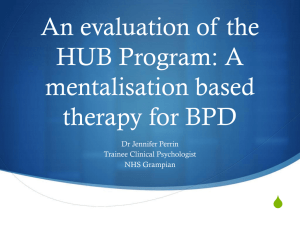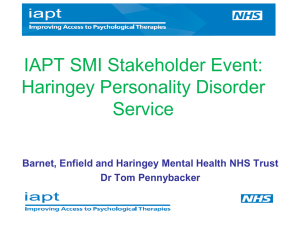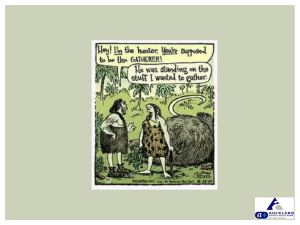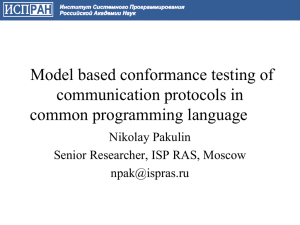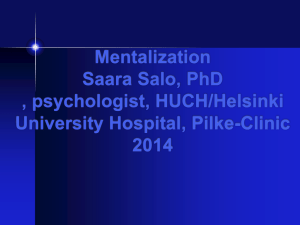Mentalization-based Treatment for borderline
advertisement
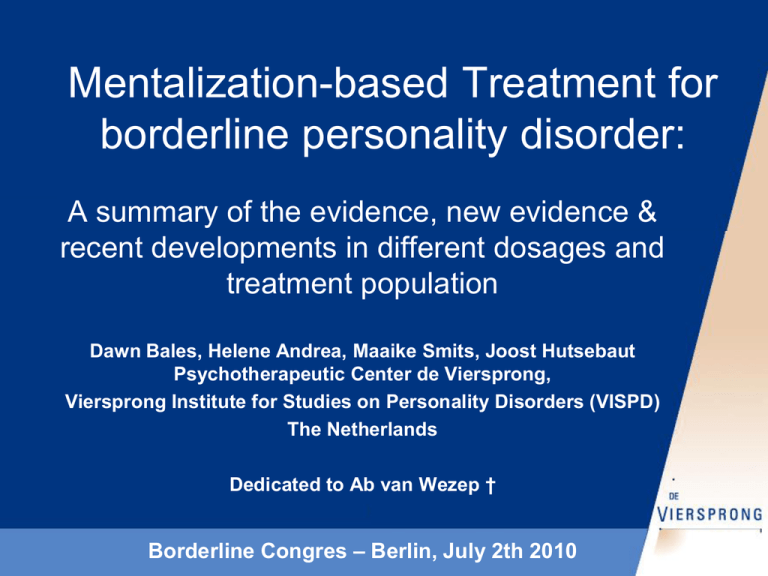
Mentalization-based Treatment for borderline personality disorder: A summary of the evidence, new evidence & recent developments in different dosages and treatment population Dawn Bales, Helene Andrea, Maaike Smits, Joost Hutsebaut Psychotherapeutic Center de Viersprong, Viersprong Institute for Studies on Personality Disorders (VISPD) The Netherlands Dedicated to Ab van Wezep † Borderline Congres – Berlin, July 2th 2010 Research team De Viersprong – Roel Verheul, Dawn Bales, Maaike Smits, Helene Andrea, Joost Hutsebaut, Katharina Koch, Fieke v/d Meer Erasmus University Rotterdam – Reinier Timman, Jan van Busschbach Tilburg University – Marieke Spreeuwenberg & MBT Staff (De Viersprong, Bergen op Zoom, The Netherlands) Internet: www.vispd.nl / presentations Email maaike.smits@deviersprong.nl Does MBT work? A summary of the evidence Dawn Bales Content Mentalization-Based Treatment (MBT) A summary of the evidence & new evidence Does MBT work? Are the effects lasting? What does it cost? Does MBT work in another dosage? Does MBT work for another population? • Double diagnosed patients • Adolescents New developments Mentalization-based Treatment Psychoanalytically oriented; based on attachment theory Developed in the UK by Bateman & Fonagy Evidence-based DH and IOP treatment for patients with severe BPD Maximum duration of 18 months Focus: increasing patient’s capacity to mentalize Essential features of the program Highly structured Consistent and reliable Intensive Theoretically coherent: all aspects aimed at enhancing mentalizing capacity Flexible Relationship focus Outreaching Individualized treatment plan Individualized follow-up Goals To engage the patient in treatment To reduce general psychiatric symptoms, particularly depression and anxiety To decrease the number of self-destructive acts and suicide attempts To improve social and interpersonal functioning To prevent reliance on prolonged hospital stays A summary of the evidence 1. Does MBT work? RCT Day-hospital vs TAU Partial Replication Study (1999 UK, 20.. NL) (2010 NL) 2. Are the effects lasting? 18 month Follow-up Long term follow-up (2001 UK, 2011 NL) (2009 UK) 3. MBT vs. other psychotherapy? (2010 ? NL) 4. What does MBT cost? (2003 UK, 2011? NL) 5. Does MBT work in another dosage? RCT IOP Start RCT Dosis (2009 UK) (2010 NL) 6. Does MBT work for another population? • Double diagnosed patients • Adolescents Does MBT work? MBT De Viersprong •First study manualized DH MBT outside UK • Research question: What is the applicability and treatment outcome of day hospital Mentalization Based Treatment for severe BPD patients in the Netherlands? • Naturalistic setting N=45 severe borderline patients with high comorbidity on both axis I and II Bales et al., submitted, 2010 Example patient Because of anonimisity reasons, this information has been deleted Treatment outcome 0-18 months UK & NL Depression (BDI) 45 40 Effectsize NL 1.26 36 36.3 35 30 27 26.7 25 25.3 20.6 20.5 20 14.6 15 10 5 0 UK (n=19) Start NL (n=45) 6 months 12 months 18 months Submitted for publicaton – do not quote Treatment outcome 0-18 months UK & NL Symptom distress (SCL-90) 3 Effectsize NL 1.23 2.8 2.6 2.4 2.2 2.5 2.4 2.2 2.1 2 1.73 1.8 1.6 1.6 1.37 1.4 1.2 1 0.79 0.8 0.6 0.4 UK (n=19) Start NL (n=45) 6 months 12 months 18 months Submitted for publicaton – do not quote Treatment outcome 0-18 months UK & NL Interpersonal problems (IIP) 3.4 3.2 Effectsize NL 1.36 3.05 3 2.8 2.6 2.4 2.42 2.38 2.2 2 1.86 1.8 1.6 1.4 UK (n=19) NL (n=45) Start 18 months Submitted for publicaton – do not quote Treatment outcome 0-18 months UK & NL % of patients commiting parasuicidal behavior (past 6 months) 94.7% 100% 90% 80% 79.0% 70% 60% 51.00% 50% 40% 37.0% 32.0% 30% 19.0% 20% 6.0% 5.3% 10% 0% UK (n=19) NL (n=45) Self harm start Self harm 18 months Suicide attempts start Suicide attempts 18 months Submitted for publicaton – do not quote Results Personality pathology Self control 5.00*** Identity integration 4.51*** 5 3.96** 6 months 12 months 18 months Responsibility Mean score SIPP identity integration Mean score SIPP Self control 6 5.5 5 4.5 4 3.73 3.5 3 start 4.30*** 4.5 3.5 3 2.96 2.5 start 3.17* 6 months 12 months 18 months Relational functioning 4 3.64 5 3.78 3.5 3 start Mean score SIPP Social concordance 4.13*** 3.75*** 4 4.76*** 6 months 12 months Social- concordance 7 6.5 5 4.40*** 4.5 4.00** 4 3.5 3.56 3.40 3 start 6 months 5.93*** 6 5.5 18 months Mean score SIPP Relational functioning Mean score SIPP Responsibility 5 4.5 4.88 5.16* 5.43*** SIPP: Verheul et al, 2008 Effectsizes 1.23– 1.74 4.5 4 start 12 months 6 months 12 months 18 months very large 18 months Results and conclusion DH MBT Low dropout rate (n=4; 8.9%) despite limited exclusion criteria Significant improvement on all outcome measures with effect sizes ranging from large to very large Not only symptomatic improvement but also improvement in interpersonal and personality functioning Results comparable to results of Bateman & Fonagy (1999) Bales et al., submitted, 2010 A summary of the evidence 1. Does MBT work? RCT Day-hospital vs TAU Partial Replication Study (1999 UK, 20.. NL) (2010 NL) 2. Are the effects lasting? 18 month Follow-up Long term follow-up (2001 UK, 2011 NL) (2009 UK) 3. MBT vs. other psychotherapy? (2010 ? NL) 4. What does MBT cost? (2003 UK, 2011? NL) 5. Does MBT work in another dosage? RCT IOP Start RCT Dosis (2009 UK) (2010 NL) 6. Does MBT work for another population? • Double diagnosed patients • Adolescents Are the effects lasting? 18 month Follow-up UK 2001: MBT patients maintained and even showed additional improvement of symptomatic and clinical gains during 18 months follow-up 18 month Follow-up Netherlands Preliminary results analyzed June 2010 N= 61 Highly comorbid borderline patients 18 month follow-up UK and NL Mean score Beck Depression Inventory Depression (BDI) 25 22.1 20 19 16.5 15 13.7 13.3 11.9 11 10 8.3 5 0 UK (n=22) 18 months 24 months NL (n=61) 30 months Preliminary results 2010 – do not quote 36 months 18 month follow-up UK and NL Symptom distress (SCL-90) 2.2 2.1 2 Mean score SCL-90 1.8 1.6 1.6 1.4 1.2 1.1 1.1 1 0.9 0.8 0.8 0.7 0.6 0.5 0.4 UK (n=22) 18 months 24 months NL (n=61) 30 months Preliminary results 2010 – do not quote 36 months 18 month follow-up UK and NL Effectsize NL Mean score IIP Interpersonal problems (IIP) 2.8 2.6 2.4 2.2 2 1.8 1.6 1.4 1.2 1 0.8 0.6 0.4 0.2 0 18-36 months 1.49 2.5 2.1 1.9 1.5 UK (n=22) 18 months NL (n=61) 36 months Preliminary results 2010 – do not quote 18 month follow-up UK and NL % of patients commiting parasuicidal behavior (past 6 months) 50% 40% 30% 20% 18.2% 18.2% 10% 5.9% 0.0% 0% UK NL 18 months Preliminary results 2010 – do not quote 36 months 18 month follow-up UK and NL Borderline Symptoms 18-36 months 25 Mean score BPDSI Effectsize NL 1.98 20 18.35 Cutoff BPDSI 15 10 5 0 18 months Preliminary results 2010 – do not quote 8.93 36 months 6 5.8 5.6 5.4 5.2 5 4.86 4.8 4.6 4.4 4.2 4 start Selfcontrol Results Personality pathology 5.54 5.88 5.2 6 months 18-36 months 12 months 18 months Responsibility 5.4 5.2 5.26 5.03 5 5 4.8 4.6 4.4 4.2 3.98 4 3.8 3.6 start 4.8 4.25 6 months 12 months 18 months 4.8 4.57 4.6 4,53 4.4 4.4 start 4.53 Relational Functioning 4.8 4.8 4.6 Identity integration 6 months 12 months 18 months 4.2 4.8 4.25 4.08 4 3.8 Social concordance 6.4 6.2 6.04 6 5.8 3.6 start 12 months 18 months 6.23 5.85 SIPP: Verheul et al, 2008 5.66 Effectsizes 1.15-2.14 5.6 5.4 start 6 months 6 months 12 months 18 months very large Conclusions 18 month FU NL Results comparable to results of Bateman & Fonagy (1999): Continuing decline in depression, symptom distress, minimal acts of suicide attempts and self harm throughout follow-up period Also: continuing improvement in personality functioning and specific borderline symptoms Preliminary results 2010 – do not quote Patient example: follow-up Are the effects lasting? 8 year follow-up UK Study: the effect of MBT-PH vs. TAU • N=41 patients from original trial • 8 years after entry in to RCT, 5 years after all MBT treatment was complete Method: • interviews (research psychologists blind to original group allocation) • structured review medical notes Bateman & Fonagy (2008) Am J Psychiatry Zanarini Rating Scale for BPD : mean (SD) MBT-PH TAU Significance (n = 22) (n=15) Positive criteria n (%) 3 (13.6) 13 (86.7) χ2 = 16.5 p=.000004 Total mean (SD) 5.5 (5.2) 15.1 (5.3) F1,35 = 29.7 p=.000004 Affect mean (SD) 1.6 (2.0) 3.7 (2.0) F1,35 = 9.7p=.004 Cognitive mean (SD) 1.1 (1.4) 2.5 (2.0) F1,35 = 6.9 p=.02 Impulsivity mean (SD) 1.6 (1.8) 4.1 (2.3) F1,35 = 13.9 p=.001 Interpersonal mean (SD) 1.5 (1.7) 4.7 (2.3) F1,35 = 23.2p=.00003 Bateman & Fonagy (2008) Am J Psychiatry Suicide attempts : mean (SD) MBT-PH TAU Significance Total N mean (SD) .05 (0.9) 0.52 (.48) U = 73 Z= 3.9 p = .00004 Any attempt N (%) 5 (23) 14 (74) Bateman & Fonagy (2008) Am J Psychiatry χ2 = 8.7 df- =1 P =.003 Global Assessment of Function MBT-PH TAU Mean (SD) 58.3 (10.5) Number (%) > 10 (45.5) 60 Significance 51.8 (5.7) F1,35 = 5.4 p=.03 2 (10.5) Bateman & Fonagy (2008) Am J Psychiatry χ2 = 6.5 df = 1 p = .02 Conclusions from long term follow-up MBT-PH group continued to do well 5 years after all MBT treatment had ceased TAU did badly within services despite significant input TAU is not necessarily ineffective in its components but package or organization is not facilitating possible natural recovery BUT Small sample, allegiance effects (despite attempts being made to blind the data collection) limit the conclusions. GAF scores continue to indicate deficits. Suggests less focus during treatment on symptomatic problems greater concentration on improving general social adaptation Bateman & Fonagy (2008) Am J Psychiatry A summary of the evidence 1. Does MBT work? RCT Day-hospital vs TAU Partial Replication Study (1999 UK, 20.. NL) (2010 NL) 2. Are the effects lasting? 18 month Follow-up Long term follow-up (2001 UK, 2011 NL) (2009 UK) 3. MBT vs. other psychotherapy? (2010 ? NL) 4. What does MBT cost? (2003 UK, 2011? NL) 5. Does MBT work in another dosage? RCT IOP Start RCT Dosis (2009 UK) (2010 NL) 6. Does MBT work for another population? • Double diagnosed patients • Adolescents Matched samples: Patient characteristics and treatment outcome for MBT versus 3 other psychotherapeutic treatment settings Helene Andrea Background UK results: MBT superior to standard psychiatric care (Bateman & Fonagy 1999, 2001, 2008) As yet no direct comparison between MBT and other psychotherapeutic programs Study aim: What is the effectiveness of day hospital MBT when compared to other psychotherapeutic treatment settings? SCEPTRE: Direct comparison MBT and - Outpatient, day hospital and inpatient psychotherapy - Matched-control design Matched control study: Patient sample SCEPTRE: N=923 patients with personality pathology Referred to psychotherapy in the Netherlands N=214 BPD patients N=39 MBT N=175 other treatment setting Assignment not random -> Selection bias Correction for selection bias (baseline group differences) Propensity score A sophisticated co-variance analysis Combines several co-variates in 1 score If successful “Imitation” of random assignment Applicable in non-randomised studies MBT (n=39) vs. SCEPTRE (n=175): Baseline differences Severity personality pathology (SIPP): - Identity integration - Relational functioning - Responsibility - Self control - Social concordance Psychiatric symptoms (SCL) Quality of life (EQ-5D) Social rol (OQ-45) Personality disorders (SIDP-IV interview): - Number cluster C PDs - Number PDNOS - Number BPD criteria Treatment history (outpatient / day hospital / inpatient) Sexe Age Educational level Living situation (partner y/n) Care responsibility for children Combined in 1 score = Propensity Score MBT versus SCEPTRE before matching MBT 60 60 50 50 40 40 Frequency Frequency SCEPTRE 30 30 20 20 10 10 Mean = 0,1241811 Std. Dev. = 0,13505588 N = 175 0 0,0 0,2 0,4 0,6 Propensity Score 0,8 1,0 Mean = 0,4427772 Std. Dev. = 0,29641958 N = 39 0 0,00 0,20 0,40 0,60 0,80 1,00 Propensity Score MBT: for 31% PS too high (= too severe) -> Matching not possible Matches for n=21 MBT: N=21 SCEPTRE Setting Mean Teatment Duration Inpatient (47%) 11.7 Months (sd 8.7) Day hospital (29%) 10.2 months (sd 6.6) Outpatient (24%) 24.2 months (sd 15.5) Effectiveness analysis For the MBT and SCEPTRE matches (hence, without the “more severe MBT-patients”) Mixed model Between effect: Group comparison Within effect: Time dependency Main outcome: GSI change score (SCL) - Change score = Time of follow-up measurement – Baseline - Negative score = improvement (Preliminary) effectiveness results In favor of effectiveness MBT Conclusions Treatment groups 31% of MBT patients could not be matched; A considerable amount of MBT patients are likely excluded from other psychotherapeutic treatments Treatment outcome (Preliminary) evidence in favour of MBT when compared to other psychotherapeutic treatments In line with results of Bateman & Fonagy (1999, 2001, 2008) Limitations N is relatively small; Several relevant severity variables are missing; e.g. substance use disorders, GAF, self-harm, suicidality Relatively large amount of missings in the MBT group; Different treatment setting and durations - subgroup analysis A summary of the evidence 1. Does MBT work? RCT Day-hospital vs TAU Partial Replication Study (1999 UK, 20.. NL) (2010 NL) 2. Are the effects lasting? 18 month Follow-up Long term follow-up (2001 UK, 2011 NL) (2009 UK) 3. MBT vs. other psychotherapy? (2010 ? NL) 4. What does MBT cost? (2003 UK, 2011? NL) 5. Does MBT work in another dosage? RCT IOP Start RCT Dosis (2009 UK) (2010 NL) 6. Does MBT work for another population? • Double diagnosed patients • Adolescents What does MBT cost? Does MBT work in other dosages? - Intensive Outpatient MBT - Patients with substance use disorders Maaike Smits Total Annual Health Care Utilization Costs 15,490 10,000 3,183 20,000 TAU 30,976 30,000 MBT 27,303 40,000 44,967 50,000 52,563 60,000 0 6 months before treatment 18 months of treatment 18 months follow-up period Significantly lower cost during treatment compared to 6-month pretreatment costs for both MBT and General Care Group During FU period: annual cost of MBT 1/5 of anual General Care costs Cost-effectiveness Bateman & Fonagy, UK 2003 A summary of the evidence 1. Does MBT work? RCT Day-hospital vs TAU Partial Replication Study (1999 UK, 20.. NL) (2010 NL) 2. Are the effects lasting? 18 month Follow-up Long term follow-up (2001 UK, 2011 NL) (2009 UK) 3. MBT vs. other psychotherapy? (2010 ? NL) 4. What does MBT cost? (2003 UK, 2011? NL) 5. Does MBT work in another dosage? RCT IOP Start RCT Dosis (2009 UK) (2010 NL) 6. Does MBT work for another population? • Double diagnosed patients • Adolescents Design of intensive out-patient MBT randomized controlled trial RCT IOP-MBT vs. SCM groups (N = 134) Random allocation (minimisation for age, gender, antisocial PD) Individual (50 mins) + Group (1.5 hrs) weekly for 18 months Assessments at admission, 6 months, 12 months, 18 months Medication followed protocol IOP vs. SCM Bateman & Fonagy (2009) Am J Psychiatry Therapy MBT - weekly Support and structure Challenge Basic mentalizing Interpretive mentalizing Mentalizing the transference Medication review Crisis management SCM - weekly Support and structure Challenge Advocacy Social support work Problem solving Medication review Crisis management IOP vs. SCM Bateman & Fonagy (2009) Am J Psychiatry Percent of Sample Who Had Attempted Suicide, Self-harmed, or were Hospitalized in Last Six Months SCM Percent with Incident 100 MBT n.s. p<.02 80 p<.0002 60 40 20 0 Baseline Six Months Twelve Months Eighteen Months IOP vs. SCM Bateman & Fonagy (2009) Am J Psychiatry Percent who had made life threatening suicide attempt SCM Percent who attempt 80 MBT n.s. n.s. 60 n.s . 40 20 p<.0004 0 Baseline Six Months Twelve Months Eighteen Months IOP vs. SCM Bateman & Fonagy (2009) Am J Psychiatry Percent of who seriously self harmed n.s. SCM p <.08 80 Percent Who Self-Harm MBT p<.05 60 p<.05 40 20 0 Baseline Six Months Twelve Months IOP vs. SCM Bateman & Fonagy (2009) Am J Psychiatry Eighteen Months Average Beck Depression Scores SCM MBT 35 Mean Depression (BDI) scores 30 25 20 15 10 6 months prior to treatment 6 months 12 months End of treatment 18 months IOP vs. SCM Bateman & Fonagy (2009) Am J Psychiatry Average Interpersonal Problems Scores SCM MBT Mean Total Interpersonal Problems (IIP) scores 2.4 2.2 2 1.8 1.6 1.4 1.2 1 6 months prior to treatment 6 months 12 months End of treatment 18 months IOP vs. SCM Bateman & Fonagy (2009) Am J Psychiatry Conclusions Both groups showed improvement over 18 months BUT DIFFERENT RATES OF CHANGE MBT-OP was superior to SCM-OP – differences started to emerge after 6 months suicide attempts and severe incidents of self harm self-reported measures of psychiatric symptoms and social adjustment Rate of improvement in both groups was higher than spontaneous remission of symptoms of BPD estimated from follow-along studies Results support emphasis on highly structured treatment approaches IOP vs. SCM Bateman & Fonagy (2009) Am J Psychiatry IOP in the Netherlands Two times group psychotherapy, 75 min per week One individual contact per week Maximum duration 18 months RCT IOP versus Day hospital treatment Minimal a priori exclusion criteria A summary of the evidence 1. Does MBT work? RCT Day-hospital vs TAU Partial Replication Study (1999 UK, 20.. NL) (2010 NL) 2. Are the effects lasting? 18 month Follow-up Long term follow-up (2001 UK, 2011 NL) (2009 UK) 3. MBT vs. other psychotherapy? (2010 ? NL) 4. What does MBT cost? (2003 UK, 2011? NL) 5. Does MBT work in another dosage? RCT IOP Start RCT Dosis (2009 UK) (2010 NL) 6. Does MBT work for another population? • Double diagnosed patients • Adolescents Substance abuse among MBT patients : Prevalence and relation to treatment outcome 57%-67% BPD patients addiction problems -> MBT? Worse treatment prognosis What is the prevalence of substance abuse among MBT-patients? Additional explorative analysis: Is substance abuse related to MBT treatment outcome? N= 39 Substance abuse measuremunt:CIDI N=24 Substance use disorders study, Bales et al. (manuscript 2010) Results: Prevalence substance disorders CIDI-SAM Abuse / dependence Total population (N = 24) 79.2% (N = 19) Specific prevalences: 1. Alcohol 67% (N = 16) 2. Cannabis 58% (N = 14) 3. Cocaine 42% (N = 10) No substance Diagnosis 21% (N = 5) 1 diagnosis 13% (N = 3) 2 diagnoses 21% (N = 5) 3-5 diagnoses 29% (N = 7) 6-7 diagnoses 17% (N = 4) Mean = 2.8 diagnosis Median = 2 diagnosis Substance use disorders study, Bales et al. (manuscript 2010) Interaction time * Lifetime substance abuse Pattern for 50% of the outcome measures: SCL-90, BDI, OQ Symptom distress, OQ interpersonal relations, OQ social concordance, SIPP identity integration and Quality of life. Substance use disorders study, Bales et al. (manuscript 2010) New comparison subgroups N = 5 no lifetime substance abuse N = 19 lifetime substance abuse Diagnosis start treatment? Yes: N = 13 No: N = 6 Diagnosis start treatment Yes: N = 13 No: N = 11 (n = 5 + n = 6) Substance use disorders study, Bales et al. (manuscript 2010) Interaction time * substance abuse start treatment Pattern: - No significant interaction effect - Improvement substance abusers start treatment (n=13) resembles improvement non abusers start treatment (n=11) Substance use disorders study, Bales et al. (manuscript 2010) Summary Lifetime substance abuse: 19 lifetime-abusers versus 5 non lifetime- abusers Tendency towards stronger improvement for small group without lifetime substance abuse Substance abuse start treatment: 13 abusers versus 11 non abusers No difference in improvement over time (Preliminary) Conclusions Very high prevalence (79%) lifetime substance abuse diagnosis among MBT patients Significant improvement possible for DD patients (severe BPD and substance use disorders) Substance use disorders study, Bales et al. (manuscript 2010) BPD and addiction: Patient examples New Developments: MBT-DD MBT-PH and IOP: parallel low-frequent outpatient contact in addiction-center Plan: integrated MBT- DD treatment Program: inpatient detox 5 days a week day-hospital (PH) outpatient treatment Including system-oriented interventions Research A summary of the evidence 1. Does MBT work? RCT Day-hospital vs TAU Partial Replication Study (1999 UK, 20.. NL) (2010 NL) 2. Are the effects lasting? 18 month Follow-up Long term follow-up (2001 UK, 2011 NL) (2009 UK) 3. MBT vs. other psychotherapy? (2010 ? NL) 4. What does MBT cost? (2003 UK, 2011? NL) 5. Does MBT work in another dosage? RCT IOP Start RCT Dosis (2009 UK) (2010 NL) 6. Does MBT work for another population? • Double diagnosed patients • Adolescents Mentalization-based Treatment for severe personality disorders in adolescents Joost Hutsebaut PDs in adolescence: some facts PDs are underdiagnosed in adolescence Adolescents with PDs suffer even more than adults with PDs Adolescents with PDs cost society annually € 14479,(Feenstra et al., in prep) There are no treatment guidelines/evidence based treatments for (severe) PDs in adolescents Innovative/experimental treatment program: MBT-A What? A treatment program aiming to improve mentalizing capacities in adolescents and their parents For whom? For adolescents suffering from severe borderline PDs (and their families) Based on: Mentalization-based treatment (Bateman and Fonagy) MBT-A versus MBT: double innovation Adaptation of an adult model for adolescents Developmentally specific (Multi)systemic approach Adaptation of an outpatient model to an inpatient setting Pedagogics in line with MBT (limit setting) Dosage of intensity of attachment Described in an unpublished manual Developmental aspects of mentalizing in adolescence Adolescence has a double impact on the ability to mentalize Impact of developmental changes (biological, emotional, cognitive, social,…) on the ability to mentalize • Cognitive development enhances abilities to mentalize about others by enhancing the ability to take different perspectives, think in a more abstract way etc Impact of developmental tasks on the ability to mentalize • The need to ‘separate’ from parents reduces the ability to mentalize (at some times) about parents (and vice versa) (Multi-)systemic perspective Adolescents often are closely connected to their family of origin and experience attachment reactions of their parents • Reactions of parents are often antecedents of failure in mentalizing (and v.v.) • Parents have lost their ability to mentalize about their child • Parents and children are absorbed in unmentalizing interactions (excessive control, closing their eyes for problems) Adolescents are embedded in multiple systems influencing them (school, peer group, neighborhood, justice) Adaptations to the original model (By far) Most aspects remain unchanged Treatment principles: highly structured, coherent, consistent, focus on affect, focus on relationships, focus on here and now, outreaching,… Clinical processes: group and individual therapy, signal plan, treatment evaluations, treatment goals,… (MBT is a very adolescent-friendly model) Adaptations to the original MBT-model Some aspects (probably) remain unchanged, but deserve special attention Therapeutic attitude: • • • • open, transparant playful, use of humor flexible concerning the therapeutic frame casual, ‘real’ Interventions: • affect-focused (what do I feel) • identity-focused (what do I feel) • maybe less focused on mentalizing about others Adaptations to the original MBT-model Some aspects are new Including Mentalization-based Family Therapy (MBFT) (trial version) Including developmental tasks in the treatment plan • An important goal is also to resume a healthy developmental trajectory • Including an analysis of mental states interfering with specific developmental tasks • Including a phasing of developmental tasks Outcome monitoring: drop out 50 45 42,9 40 35 30 25 20 15 8,69 10 Historic data 20062008 MBT-A 5 0 Drop Out % Not yet published – do not quote Outcome Monitoring: symptom index Brief Symptom inventory 1,8 1,6 1,4 MBT-A KPA 1,2 1 0,8 Start treatment End Treatment Not yet published – do not quote Outcome Monitoring: level of personality problems 6 SIPP Self control SIPP Identity Integration 5 4 MBT-A 3 KPA 2 Start behandeling 6,5 4,5 4 3,5 3 2,5 2 Start behandeling Einde behandeling SIPP Social concordance Einde behandeling SIPP Relational capacities 4,5 6 5,5 4 5 3,5 4,5 Start behandeling Einde behandeling 3 Start behandeling Einde behandeling SIPP Responsability 5 Not yet published – 4,5 4 3,5 Do not quote 3 2,5 2 Start behandeling Einde behandeling Implementation was not a success over the whole line… (not at all, in fact…) Two major negative consequences Extreme levels of arousal in the patient groups Leading to much acting out, crises, high stress Extreme burden for staff (mainly nurses) Leading to temporarily high illness and drop out of staff members Causes of implementation problems Related to institution Traditional therapeutic community for neurotic patients MBT-A arose from the ‘ashes’ of such a TC program MBT-A arose from conflicts between team members of this TC Related to the start of the program Staff was not selected, but personnel was re-trained Group had to adapt to a new program Related to team Existing split between nurses and psychotherapists Team members with highly similar personality profile Abscence of experience in MBT at the start Causes of implementation problems Related to training Basic training without continuous monitoring/supervision Related to adolescent population Strong peer bonding against staff Parents blaming the therapists/institution Related to inpatient setting Too much (attachment, peer bonding) leading to high arousal Extremely difficult to maintain a consistent and coherent apporach, leading to unreliability Preliminary conclusions MBT is a promising approach for the treatment of severely personality disordered adolescents It not only reduces symptoms, but also improves core components of personality functioning MBT does not need huge adaptations for adolescents, with exception of the addition of MBFT and attention for developmental tasks Implementation of MBT is a difficult process (more general: implementation of a new treatment model in a complex population is difficult) An inpatient setting might be possible for milder PD adolescents, but is riskful for low level BPD (i.p. with strong antisocial traits) Future developments Reorganisation of the program: Intensive outpatient instead of inpatient Restricted age range (16-18) Developing an adapted version of MBFT • Integrated within MBT-a (one-team model) • CEM for parents including focus on parental skills Development of a quality monitoring system Content Mentalization-Based Treatment (MBT) A summary of the evidence & new evidence New Developments MBT-Double diagnosis (MBT-DD) MBT-Caregivers (MBT-C) MBFT MBT quality assurance and improvement system Other new developments New developments: - MBT Caregivers - MBFT MBT quality assurance and improvement system Other new developments Dawn Bales MBT QA/QI MBT Unit Supervisor team 1 DayHospital Group 1 DayHospital Group 2 Supervisor team 2 PrePostTreatment treatment CEM CEM-A CEM-C - children -- adolesc. Supervisor team 3 IOP 1 IOP 2 IOP 3 MBT-C MBFT MBT-C MBFT MBT-C MBFT MBT-A MBT-A Objectives of MBFT Help families shift from non-mentalizing to mentalization-based discussions and interactions, building a basis of trust and attachment between children and parents. Promote parents’sense of competence in helping their children develop the skill of mentalizing. Practice the skills of mentalizing, communication and problem solving in the specific areas in which mentalizing has been inhibited. Initiate activities and contexts within the family, with peers, in school, and in the community which reinforce mentalizing, communication skills and mutually supportive solutions to problems MBT for caregivers: MBT-C A mentalizing parental program for high-risk parents and their children Population: caregivers with severe BPD and their children up to four years Goal: promoting reflective parenting by enhancing the caregiver’s mentalizing with respect to him/herself, the child and the relationship The interventions on caregiver-child interactions are based on principles from Minding the baby (Slade) Plan MBT-C Program: Course explicit mentalizing (8-10 group sessions) Course explicit mentalizing for caregivers (6-8 group sessions) IOP MBT (1 group psychotherapy and 1 individual session, with primary focus on their BPD) Interventions on caregiver-child interaction: homevisitations and routine videotaping of caregiverchild interactions Research: MBT-C versus TAU Hypothesis: enhancing the caregiver’s mentalizing capacity results in less psychopathology in the children Content Mentalization-Based Treatment (MBT) A summary of the evidence & new evidence New Developments MBT-Double diagnosis (MBT-DD) MBFT MBT-Caregivers (MBT-C) MBT quality assurance and improvement system Other new developments Borderline Task Force (NL) Prominant researchers and clinicians from different evidence-based BPD treatment programs (MBT, TFP, SFT en DBT). Mission: Jointly contributing to more (cost)effective BPD treatment programs and To increase the amount of BPD patients receiving evidence-based (cost)effective BPD treatment. In company MBT Training 2x half day Teammanager/ project leader Kick off Team 2-day basic training Team 3rd day basictraining Team Training on-the-job 5 days 3 therapists First day extra training Team Second day extra training Team Teamsupervision Team Individual supervision ; 8x 1 x p 6 weeks All therapists Individual supervision : 6 x 1 x ST p 2 months Optional Training MBT Nr. Phase training Result Implementa tion. MBT Result Problem program 1. Finished - +_ Reorganisation, cut-backs, no evidence-based program 2. Finished - + Goal was to add certain components facilitating mentalizing 3. Finished +- +- splitting, reorganization, new start 4. Finished + -; ended 5. Finished +- Small, vulnerable team, working on recovery 6. Finished ended Implementation problems; problems in team, not enough expertise, adherence low, splitting 7. Middle phase ± Small, vulnerable team, no support from management 8. Finished ± Complex organization, low adherence, splitting,, reorganisation Framework for MBT: Succes factors Multi System Therapy (MST)? Evidence-based product MST program development and support Consultation, training and boostersessions Quality assurance and improvement system Research supporting QA/QI linkages with outcome Components of QA/QI system Training Manualized training, supervision on site, consultation and booster training Implementation measurement and reporting Therapist adherence measure, program adherence measure, supervisor adherence measure and consultant adherence measure Outcome measurement Organisational support Organisational manual Pre-implementation program development process, Ongoing organizational support Quality assurance and Improvement System (MST model) Manualized Therapist & program Supervisor Organization Manualized Supervisory Adherence Measure Patiënt Therapist Adherence Measure Implementatio n program Manualized MBT Expert/consultant MBT Expertisecenter Manualized Other new MBT Developments MBT for ASPD Children/parents (MBKT, NPi, NL) Eating disorders RCT MBT with eating disorders (UK) Phd on MBT with Severe eating disorders (GGZ-MB, NL) Severe psychosomatic disorders (Eikenboom, NL) Conclusions A summary of the evidence MBT does work for severe borderline patients The effects are lasting MBT shows considerable health care cost savings after treatment MBT-IOP also seems effective MBT is also promising for addiction and adolescents Internationally many new developments www.deviersprong.nl www.vispd.nl/presentations dawn.bales@deviersprong.nl maaike.smits@deviersprong.nl helene.andrea@deviersprong.nl joost.hutsebaut@deviersprong.nl
